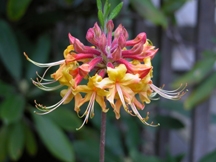 |
|
We grow, sell, and ship the best azaleas and camellias in
the USA, found via our website. We ship
quickly via USPS Priority mail.
Plants are shipped out on Mondays, Tuesdays, Wednesdays, and
sometimes on Saturdays....Most plants will be sent bare root wrapped in
wet sphagnum moss and a plastic bag wrapped in tape for security, and sent via
USPS Priority Mail. When plants arrive be sure and soak in water overnight and
then plant. I take great care in
wrapping plants to assure they arrive safely, but sometimes the Post Office
gets careless and damages the package(See “Damage” under shipping) I only ship plants to lower 48 states,
Alaska, Hawaii, U.S. Protectorates, and APO/FPO address no international
shipping at this time, but am working on same on a country by country basis, so
email me with any requests! If there are any certificates or special shipping
costs above and beyond what normally occurs in my regular shipping to the lower
48 states...buyer is responsible to tell me and pay any additional costs
incurred. Please immediately email or
call me upon arrival of shipment, for any problems that you think might have
occurred. John Talbott
|
|
|